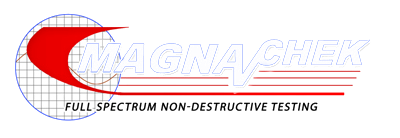Ultrasonic inspection involves the transmission of ultra-high frequency sound waves through the part being tested and evaluating the reflected waves on a time delay oscilloscope.
It is useful for detecting sub-surface discontinuities, dimensional measurements (thickness) and analyzing material structure. In a typical pulse/echo ultrasonic inspection system, a transducer in contact with the test specimen generates high frequency ultrasonic energy that travels through the test specimen in the form of waves. The waves reflect back to the transducer off the opposite wall of the specimen. Any discontinuity in the path of the waves—a crack or inclusion, for example—will reflect part of the energy back to the transducer. The reflected wave is transformed into an electrical signal by the transducer and displayed on an oscilloscope. Typically, the strength of the reflected signal is plotted against the elapsed time from signal generation (pulse) to the moment the reflected signal (echo) is received. Signal travel times can be converted to the distance traveled, which can yield information on the location, size and orientation of the discontinuity.
Immersion testing provides inspection alternatives
Contact ultrasonic inspection is somewhat limited as to the size of discontinuities it can detect—generally no less than one millimeter. To locate smaller defects, immersion testing, where both the test specimen and transducer are immersed in a tank of water, is frequently used. However, because the sound waves are traveling through a second medium—water—before entering the test specimen there are additional echoes to interpret that is best done by a skilled operator.
Ultrasonic inspection is versatile
With both contact and immersion methodologies available, ultrasonic inspection is used for a wide variety of applications. It is frequently used to check weld quality on containment vessels and the integrity of aircraft wing and tail attachments.
Acceptable Standards
ISO 7963, Non-destructive testing – Ultrasonic testing – Specification for calibration block No. 2
ISO/DIS 11666, Non-destructive testing of welds – Ultrasonic testing of welded joints – Acceptance levels
ISO/DIS 17640, Non-destructive testing of welds – Ultrasonic testing of welded joints
ISO 22825, Non-destructive testing of welds – Ultrasonic testing – Testing of welds in austenitic steels and nickel-based alloys
Limitations
Surface must be able to transmit ultrasound
Skills and training of the ultrasonic technician are more extensive than other methods
Discontinuities that are oriented parallel with the beam energy will usually not be detected
Normally requires a coupling medium to provide transfer or sound energy
Materials that are rough, irregular in shape are difficult to inspect
Cast iron and coarse grain are difficult to inspect due to low sound transmission and big signal noise
Reference standards are required for both equipment calibration and the characterization of flaws
Advantages
Highly sensitive to both surface and sub-surface examinations
Methods can provide both thickness measurement and flaw detection
Superior depth of penetration
Results are instantly available
No environmental or safety hazard as is present with Radiography
Regulatory requirement
Only single side access required to perform test


